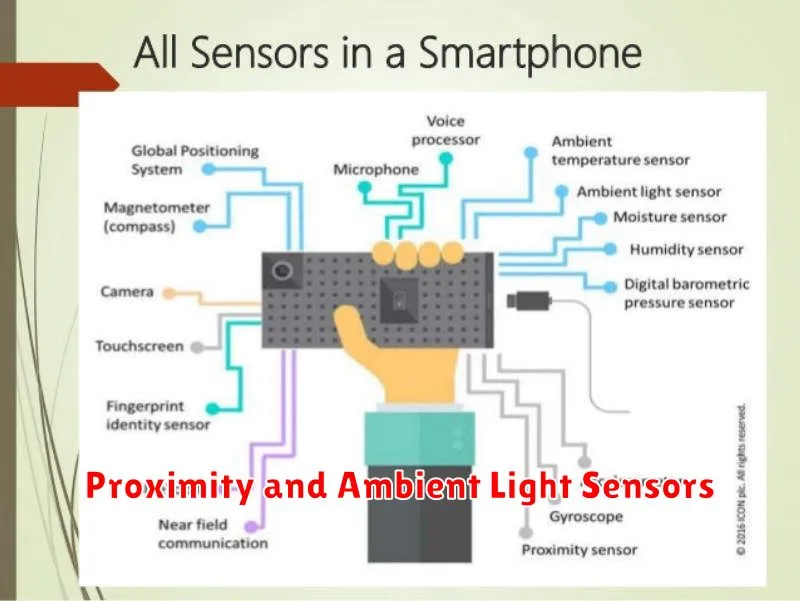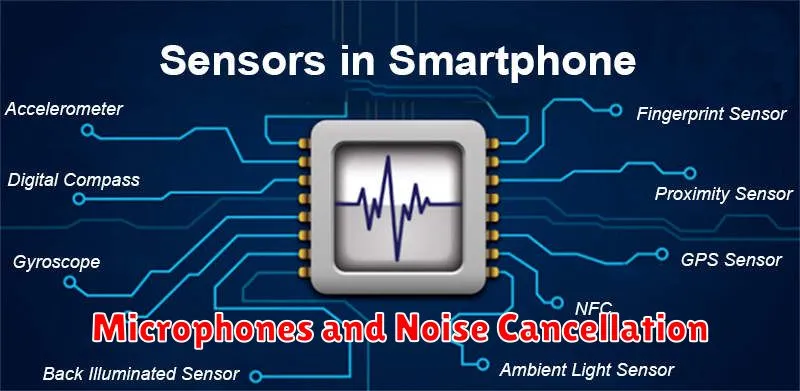Smartphones have evolved from basic communication devices to sophisticated pocket computers packed with an array of sensors. These sensors constantly monitor and interact with the world around us, enabling a plethora of functionalities that we often take for granted. Understanding how these smartphone sensors work and their diverse uses is key to appreciating the power and potential of modern mobile technology. This article will delve into the intricate workings of common smartphone sensors, exploring their individual capabilities and showcasing the innovative ways they are employed to enhance user experience.
From the accelerometer that detects motion and orientation to the proximity sensor that disables the screen during calls, each sensor plays a crucial role in shaping the smartphone’s functionality. We will explore the GPS sensor for location tracking, the ambient light sensor for automatic brightness adjustment, the gyroscope for gaming and augmented reality, and many more. By understanding the uses of these smartphone sensors, we can gain a deeper appreciation for the technology that permeates our daily lives and discover how these tiny components contribute to the smartphone’s versatility.
What Are Smartphone Sensors?
Smartphone sensors are tiny components embedded within your device that allow it to gather data about its environment and usage. They act as the bridge between the physical world and the digital realm, enabling your phone to react and adapt to various situations.
These sensors constantly monitor different parameters, converting physical phenomena like motion or light into digital signals that the phone’s processor can understand and utilize. This data allows the phone to perform a wide variety of tasks, from adjusting screen brightness to determining your location.
Different types of sensors measure different things. For example, an accelerometer measures acceleration, while a gyroscope measures orientation and rotation. These sensors work together to provide a comprehensive understanding of the phone’s state and surroundings.
Accelerometers and Gyroscopes
Accelerometers measure linear acceleration, essentially how fast the phone is changing its speed in a straight line. They detect movement along three axes (x, y, and z), allowing the phone to determine its orientation relative to gravity. This enables features like screen rotation and motion-based gaming controls.
Gyroscopes, on the other hand, measure angular velocity, or how fast the phone is rotating around an axis. They also work across the x, y, and z axes. Gyroscopes contribute to more precise motion tracking and are essential for features like image stabilization and virtual reality experiences.
Often, accelerometers and gyroscopes work in tandem to provide a comprehensive understanding of the phone’s motion in three-dimensional space.
Proximity and Ambient Light Sensors

Proximity and ambient light sensors are crucial components in modern smartphones, contributing to both user experience and device functionality. The proximity sensor detects the presence of nearby objects without physical contact. Primarily, it disables the touchscreen during calls to prevent accidental input from the cheek or ear.
The ambient light sensor measures the surrounding light intensity. This data is used to automatically adjust screen brightness, optimizing visibility and conserving battery life. These sensors work in tandem to enhance usability and power efficiency.
Fingerprint and Facial Recognition
Biometric authentication methods like fingerprint and facial recognition have revolutionized smartphone security. These sensors enhance user convenience while offering robust protection against unauthorized access.
Fingerprint sensors, often embedded in the power button or under the display, use capacitive or ultrasonic technology to map the unique ridges of a fingerprint. When a user attempts to unlock their device, the sensor captures a new scan and compares it to the stored fingerprint data. If the scans match, the device is unlocked.
Facial recognition utilizes the front-facing camera to create a 3D map of the user’s face. This map incorporates distinct facial features, enabling the device to authenticate the user’s identity. Advanced systems utilize infrared light to ensure accurate recognition even in low-light conditions.
GPS and Navigation Sensors
Global Positioning System (GPS) technology is a cornerstone of modern smartphone navigation. It allows devices to determine their precise location on Earth by receiving signals from orbiting satellites.
In addition to GPS, smartphones utilize other navigation sensors to enhance location accuracy and provide directional information. These include:
- Accelerometer: Measures acceleration forces, helping detect movement and orientation changes.
- Gyroscope: Measures rotation and angular velocity, contributing to precise motion tracking.
- Magnetometer: Acts as a digital compass, detecting magnetic north and aiding in orientation.
The combined data from these sensors enables features like turn-by-turn navigation, location-based services, and augmented reality applications.
Health Monitoring Sensors
Modern smartphones have evolved into powerful health monitoring tools, thanks to the integration of sophisticated sensors. These sensors enable users to track various health metrics and promote a healthier lifestyle.
A key player is the accelerometer, which measures acceleration forces. This allows for step counting, activity recognition (e.g., walking, running), and even fall detection. Furthermore, the gyroscope detects rotation and orientation, contributing to more accurate activity tracking and motion sensing.
Heart rate sensors, often optical, utilize light to measure blood flow and calculate heart rate. Some devices even include SpO2 sensors, which measure blood oxygen saturation levels, a vital indicator of respiratory health. ECG sensors, available on select smartphones, provide electrocardiogram readings, allowing users to monitor their heart rhythm for irregularities.
Barometers and Altimeters
Smartphones often incorporate a barometer, a sensor that measures atmospheric pressure. This data is primarily used for altitude calculations, enabling features like floor detection and enhanced GPS accuracy. Changes in pressure correlate to changes in altitude, allowing the device to estimate vertical position.
An altimeter utilizes barometric pressure readings to determine height above sea level. While a barometer measures pressure, an altimeter interprets that pressure to provide altitude information. This is particularly useful for hiking, climbing, and other activities where knowing elevation is important.
Some devices combine barometer readings with GPS data to improve location accuracy, especially in areas with weak GPS signals, such as within buildings or dense urban environments.
Microphones and Noise Cancellation

Smartphones typically employ multiple microphones, playing a crucial role beyond voice calls. These microphones facilitate various functionalities such as video recording and voice commands.
A key function of these microphones is noise cancellation. This technology significantly reduces background noise during calls and recordings, enhancing audio clarity. Active noise cancellation utilizes strategically positioned microphones to analyze and counteract ambient noise, while passive noise cancellation relies on physical barriers within the microphone design to minimize unwanted sound.
Using Sensors for Security
Several sensors contribute significantly to smartphone security. The accelerometer and gyroscope can detect unauthorized movement, triggering alarms or locking the device if it’s dropped or snatched. Fingerprint sensors and increasingly sophisticated facial recognition systems utilizing the front-facing camera provide biometric authentication for device access and app security.
Proximity sensors enhance security during calls by disabling the touchscreen when the phone is held close to the ear, preventing accidental input. These sensors can also be employed in basic intrusion detection systems by triggering an alert if an object comes too close to the device when left unattended.
The Importance of Sensor Calibration
Sensor calibration is crucial for ensuring the accuracy and reliability of data obtained from smartphone sensors. Over time, sensors can drift from their factory settings due to factors like temperature changes, physical shocks, and general wear and tear. This drift can lead to inaccurate readings, affecting the performance of applications that rely on sensor data.
Calibration involves comparing the sensor’s output to a known, accurate reference. This process helps to correct any deviations and restore the sensor’s accuracy. Regular calibration is particularly important for applications that require precise measurements, such as navigation, augmented reality, and fitness tracking.
Without proper calibration, sensor data can become unreliable, leading to frustrating user experiences and potentially dangerous situations. For example, inaccurate accelerometer data can lead to incorrect orientation in navigation apps, while faulty gyroscope readings can cause problems with motion-based gaming or virtual reality experiences.

